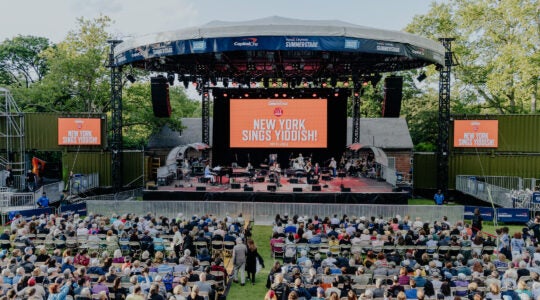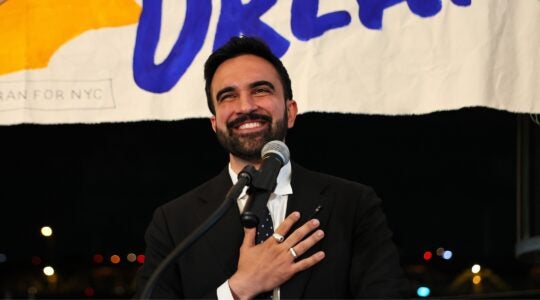Jeffrey Cymbler of Forest Hills, Queens, visited museums in Poland, Israel’s Yad Vashem Holocaust museum/research center and the Auschwitz Museum before learning in 2011 about the extensive archives at the U.S. Holocaust Memorial Museum.
“I believe it is better to do your own research, but I didn’t have the time,” he said. “So I sent them an inquiry about my father and on April 1, 2011, I got a detailed e-mail about my father and copies of his records — some I had never seen before.”
Cymbler said he even received a copy of his father’s registration form when he was brought as a prisoner to the Dachau concentration camp on Aug. 6, 1944.
“It was sent as a PDF document in the e-mail,” he said. “I was very pleased to see it; it even has his signature. Some of the stuff they sent I already knew, but the documents I had not seen before. I’m certain they will have information about other family members, but I have not yet had a chance to make an inquiry.”
Although the Holocaust archives at Yad Vashem and at Ancestry.com have garnered more media attention, those at the Holocaust Memorial Museum in Washington, D.C., are among the world’s largest and most comprehensive repositories of Holocaust-related records. Not only do the museum’s archives include records from Germany but also material held by state and private archival institutions in virtually every European country — including countries of the former Soviet Union. In addition, there are the records of the International Commission on Holocaust Era Insurance Claims, personal papers, memoirs and testimonies of Holocaust survivors, victims, liberators and historians.
To mark its 20th anniversary, the museum is conducting a national tour that comes to the New York Hilton March 3 and will enable visitors to conduct online archive searches there. From 9 a.m. until 5 p.m., the museum will hold a tribute to local survivors and World War II veterans, and will conduct programs dealing with such things as the museum’s artifacts and various questions about the Holocaust. Those planning to attend the free event are asked to register online at www.ushmm.org/neveragain.
At such an event recently in Boca Raton, Fla., the son of a survivor asked a researcher about his grandfather and learned what happened to him during and immediately after the war. And a search for a survivor turned up a copy of her birth certificate.
The museum has a three-member staff plus volunteers devoted to providing this free search of its print and photo archives, which number 64.6 million pages (including double-sided pages that count as one). There are an additional 135 million digital images from nearly the entire collection stored by the International Tracing Service in Bad Arolsen, Germany — including original records from Nazi concentration camps, details of forced labor and files of displaced persons. Those archives, under the administrative umbrella of the International Committee of the Red Cross, were opened to the public in 2007.
The museum has received 17,675 archival requests from 70 countries since 2008, according to Diane Asoumado, chief of the museum’s international tracing service research branch, which assists survivors, their families and the families of Holocaust victims.
Requests can be submitted by mail, fax or e-mail.
“The easiest way is to go online and complete the form,” Asoumado said. “Enter whatever information is requested and it goes into our system and we start researching … You don’t need to come to the museum to search our archives.”
She said the archivists search “millions of documents” in 27 different languages.
“It’s a lot of work. We have sent up to 90 documents to one person to complete a request. …When we look at the documents on our screen, we are not looking at archival material — we are looking at people. We are talking about individuals. We think of what happened to that person and try to reconstruct the puzzle as best we can. This is not work, it is a service.”
Hannah Berliner Fischthal, 65, of Jamaica Estates, Queens, said she contacted the museum’s archival branch after her requests to other organizations were unable to uncover information about her father’s family.
“We knew that just about everyone in the family had been killed — at least 100 family members,” she said. “The only survivors were my father, Murray Berliner, two of his brothers and their sister. I wanted to find out about the brother my father was closest to, Abram Chaskiel Berliner. He was born in 1910, and there were rumors he had survived by staying with a friend. They had lived in Dabroa Gornicza in Poland. I just thought it would be wonderful if I could find him or get some information.”
Although information about much of the rest of the family was found, Fischthal said no information was uncovered about her missing uncle.
Asoumado said that when her office is unable to find the information being sought, it will suggest other places to look. But she said a record would only be kept if the person in question had been deported.
“If a person was murdered on location, there is little chance of finding out about him,” she said.
Fischthal, an adjunct professor of English at St. John’s University, in Queens, said her inquiry to the Red Cross turned up her aunt’s birth certificate and that from an online search with www.jri-poland.org she was able to get the names and birth dates of other family members.
“I was able to document about 20 people who were killed,” she said. “It opened a whole new world. By being able to document them and put their names in Yad Vashem, which did not have them, I was able to memorialize them. It’s a testament to the victims, and it is a way to refute the [Holocaust] deniers.”
The most interesting information the museum uncovered for her was about a family member who died April 21, 1945, “one day after a death march was set in motion.”
“We had heard rumors he had been shot on a death march from Auschwitz, but it turns out he was on a death march from Flossenburg,” she said. “I learned there were 22,000 prisoners on that death march and the SS guards shot and killed any prisoner too ill or weak to keep up. At least 7,000 were killed before reaching Dachau, where they were liberated by the Americans on April 29, 1945.”
Patti Rudowsky, 52, of Bradley Beach, N.J., said she began her search about her father’s past while going through papers after her mother’s death in 2009.
“I found my father’s release papers from a DP [displaced person’s] camp in Poland and that is what got me intrigued about how I got here,” she said. “I asked the museum to find the missing link for me and they came up with documentation that was amazing. They even had a form my father had filled out that they Nazis gave him. To see the documentation — and his fingerprints — was amazing. What before had been a story became a reality.”
steve@jewishweek.org
The New York Jewish Week brings you the stories behind the headlines, keeping you connected to Jewish life in New York. Help sustain the reporting you trust by donating today.




